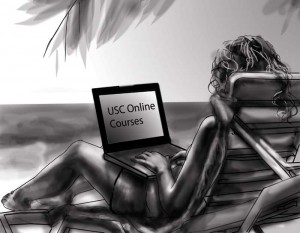USC must step up online curriculum
A growing number of USC undergraduates come from outside of Southern California. To catch up on units or to ease the course load during the school year, many students opt for summer school.
Many of those students, however, prefer not to stay in Los Angeles to attend USC summer classes, but getting USC to accept credit for classes taken elsewhere can sometimes be difficult.
Online classes appear to be the solution to this impasse.
Online classes have already been shown to be successful at USC.
Since USC’s online Master of Arts in Teaching program, MAT@USC, was created two years ago, the program has expanded ten-fold to enroll more than 1,500 current and aspiring teachers, according to a USC press release.
Through the program offered by the Rossier School of Education, online students have the same graduation requirements and identical coursework as students on campus. The program is fully accredited, and online students enjoy the same benefits as any other Trojan. The only difference between online and on-campus is location.
Given the success of offering entire master’s degrees online, it seems entirely feasible to offer more online courses for undergraduates — particularly during the summer.
Online classes still have the stigma of being “less rigorous” than on-campus courses, but that perception fades with research. Online courses demand the same amount of time, effort and commitment. The only difference is students and professors do not all have to be physically present in the same location.
Opponents have argued online courses can limit interactions between students or between the student and the professor, harming the learning experience.
Currently, courses in the online master’s degrees are interactive, featuring weekly or biweekly video classroom lectures or discussions that resemble a real-time Skype session with several students and a professor.
Students also use discussion forums and blogs to stay connected and to form an interactive community. Occasionally, students might even upload videos of their assignments, like shadowing a teacher in an elementary school.
Professors and students participate in online discussions and, with the help of interactive technology, can have real-time interactions.
For online courses, professors still have “office hours,” but it involves signing on to a video chat session during certain times of the week, instead visiting an actual office.
And students can literally take the classroom with them with the MAT@USC iPhone and iPad apps, which allow them to chat with classmates about the next exam. During scheduled class time, they “press a button to virtually raise their hand,” according to MAT@USC.
Though certain courses, such as chemistry with its laboratory experiments and biology with its dissections, might not be entirely feasible as all-online classes, many general education requirements or introductory courses could be transformed into online summer options for students seeking to explore another field of study or rack up some credits for their current major.
According to the 2010 Sloan Survey of Online Learning, more than 5.6 million students nationwide were enrolled in one or more online courses, and the number is increasing exponentially.
Online education has proven to be a viable and effective teaching method with graduate education and should be seriously considered at the undergraduate level for students seeking summer classes.
Rebecca Gao is a freshman majoring in global health and biological sciences. Her column, “Trojan Grounds,” ran Mondays.


Comments are closed.